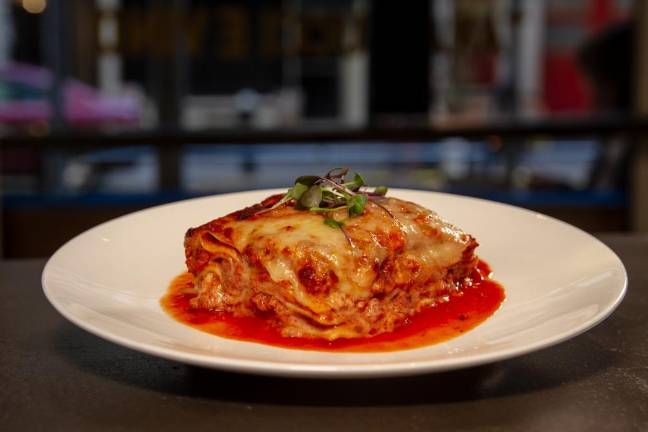What started as a lasagna delivery to a city hospital has grown into a nationwide philanthropic effort. Just days after the COVID-19 pandemic shuttered four of his five Tarallucci e Vino restaurants, Luca Di Pietro received a request from a friend wanting to make a food donation to NYU Langone. After the restaurateur and his wife personally delivered lasagna, panini and salad to 40 ER doctors and nurses, and he saw how appreciative they were, it left him wanting to contribute more.
That same night, the Italian native-turned-Upper West Side resident consulted with his family, and Feed the Frontlines NYC was born. His idea was simple; generous people would buy meals and his staff would prepare dishes like salmon and farro, pesto-marinated chicken and orecchiette with broccoli rabe, and deliver them to hospitals throughout the city. On their first day in operation, they received over $12,000 in contributions and purchases. And to date, they have distributed more than 103,000 meals not only to hospitals, but shelters and supportive housing residences as well.
As a result of his charitable mission, Di Pietro, who had to initially lay off 95 employees, was able to rehire 51 of them. He also took on 18 restaurant partners, which resulted in over 60 more workers being brought back to work. Other cities also took notice, and sister initiatives have popped up in places like San Diego, Miami and Boston. Governor Andrew Cuomo even recognized the efforts of Di Pietro and Feed the Frontlines NYC in one of his daily online messages to New Yorkers.
This labor of love is shared by many, from Di Pietro’s daughter Isabella, who is by his side seven days a week, to a longtime customer who is delivering and taking photos for their Instagram page. “New Yorkers never fail to surprise,” he said. “We’re tough, but we know what is good and we know when a good thing is a good thing. That’s one of the reasons why I love the city. It’s just been a very heartwarming experience. And it’s been a good thing.”
Tell us how the idea for Feed the Frontlines came about.
Shortly after the announcement of closing the restaurants, a friend of mine, Adair Roberts, who’s in Toronto, said, “I want to help out and buy some food for people.” So she found a contact at NYU Langone, and purchased 40 meals. We went there and four people, nurses and doctors, came out to pick up the food curbside. And they were so appreciative. They were just so happy to see someone bringing food. Because they were getting very busy. “I can’t believe you’re doing this. It’s such a morale boost. It’s hard for us to get out and find food,” they said.
That made quite a big impression. That evening, talking to my wife Kate and my daughter Isabella and my son Ian, I said, “Maybe we can do this and try to keep our lights on.” So I talked to a few friends and one of my friends I play soccer with said, “Hey, next time you make a delivery, I’ll buy the next 50 meals.” The following day, we did a delivery at NYU Langone in Sunset, Brooklyn. And from there, speaking with my daughter, who had just come back from college, we decided to put together a website. And she, with a friend from school, created a website in 18 hours.
You also joined forces with a nonprofit to help the homeless.
We partnered with a not-for-profit, the JoyJ Initiative; they are a 100-percent volunteer-based organization that does homeless outreach. We formalized our partnership at the end of April, but what is happening now, because the crisis in the hospitals is slowing down, the crisis among New Yorkers is ramping up. As you may have heard, there were 1.2 million New Yorkers who were considered food insecure before the crisis. And those numbers have basically doubled since the crisis started. In the not-so-poor neighborhood on the Upper West Side where I live, you have people lining up for food pantries. The city is really struggling to keep up with the demand of food. And what we’re doing now is we’re trying to help New Yorkers who are experiencing food insecurity. This is the next part of our effort. We’re talking to the city. We got a grant from the Robin Hood Foundation about a week ago to help us in this effort. If you just think of restaurant workers, who usually live paycheck to paycheck, when the paycheck ends, where are they going to get meals from?
What is your long-term goal with this outreach?
Our big idea is to get restaurants to help with this city’s need. We don’t need big corporations sending canned food and Cheerios. We want to have restaurants who know how to cook and prepare food safely help. And the city should realize that this will be a mutual benefit because we are going to lower the rates of people who are food insecure, but also keep the lights on in many restaurants. Otherwise, who knows what’s going to happen to all these restaurants? The last time I had a conversation with the president of the New York State Restaurant Association a month ago, they were thinking that at least 30 percent of New York State restaurants would not reopen. And we were imagining 40 to 50 percent in the city. And the longer we wait, the harder it’s going to be. My idea is to have hopefully more restaurants involved. If we were to get funding from FEMA, or the city itself, we could bring more restaurants to help.
To donate a meal, please visit www.feedthefrontlinesnyc.org


